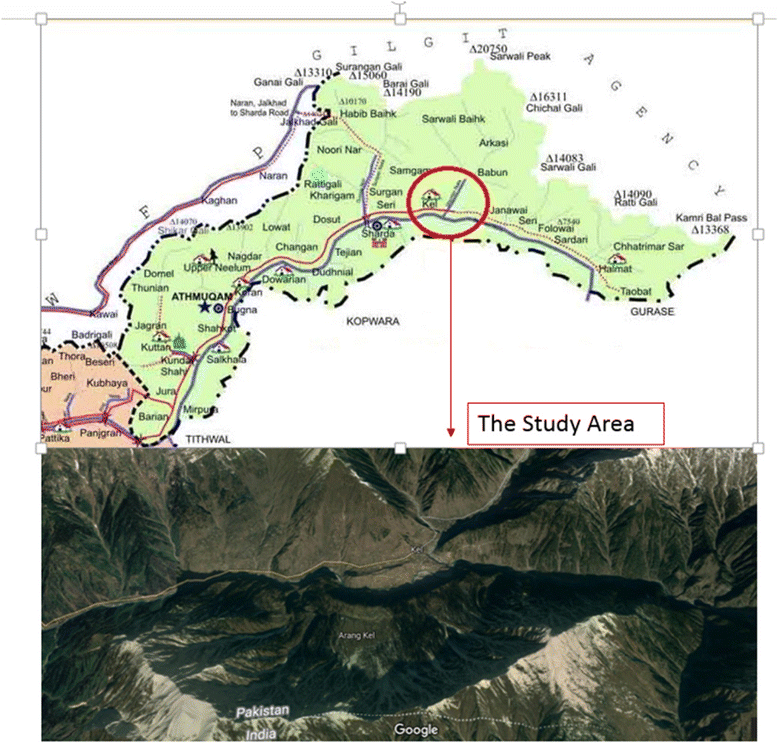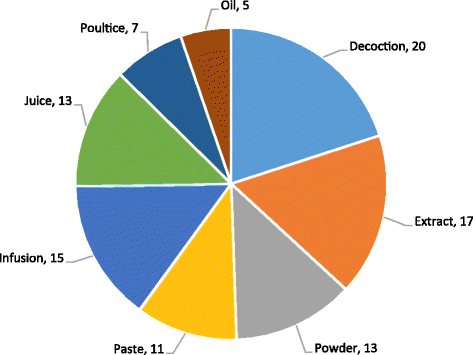Ethnopharmacological studies of indigenous plants in Kel village, Neelum Valley, Azad Kashmir, Pakistan
- PMID: 29191238
- PMCID: PMC5709976
- DOI: 10.1186/s13002-017-0196-1
Ethnopharmacological studies of indigenous plants in Kel village, Neelum Valley, Azad Kashmir, Pakistan
Abstract
Background: This explorative study was undertaken for the first time in Kel village located in the Upper Neelum Valley, Azad Kashmir, Pakistan. The purpose was to document the indigenous knowledge of the native people used in the preparation of herbal medicines.
Methods: To get the data on traditional uses of medicinal plants, 20 informants were interviewed. Quantitative ethnobotanical indices, i.e., use value (UV), relative frequencies of citation (RFC), informant consensus factor (Fic), fidelity level (FL), data matrix ranking (DMR), preference ranking (PR), and jaccard index (JI), were calculated for the recorded medicinal plants.
Results: A total of 50 medicinal plants belonging to 33 families used in 13 disease categories were documented. Leaves were the frequently used plant parts, and decoction was the commonly used method for herbal medicine. Plants with high use value were Berberis lycium (2.05), Impatiens glandulifera (1.95), Artemisia scoparia (1.75), Ageratum conozoides (1.75), and Achillea millefolium (1.7). The highest RFC value was calculated for Berberis lycium (0.75), Cynoglossum lanceolatum (0.65), and Impatiens glandulifera and Achillea millefolium (0.60 each). The maximum informant consensus factor was for urinary system, cardiac diseases, baldness, and abortion and miscarriage (1.00). Berberis lyceum (95%) used in jaundice, hepatitis, typhoid, fever, and tuberculosis disorders. Plants with maximum fidelity level (FL) were Berberis lycium (95%) followed by Dioscorea bulbifera, Impatiens glandulifera, and Artemisia vulgaris (90%). Olea ferruginea was the most multipurpose plant and exports (21.2%) was the leading threat in the area. The pearson correlation coefficient (0.500) showed a positive correlation between the use value and relative frequency of citation.
Conclusion: The present study provides useful information about traditional uses of medicinal plants used by local communities in different ailments. The plants with the highest use values could be employed in pharmacological research and biotechnological approaches in order to achieve adequate revenue. Some of the plants in the study area are facing high threats of becoming rare, and conservation initiatives are needed to conserve them for sustainable management in the region.
Keywords: Ethnobotany; Informant consensus factor; Jaccard index; Neelum Valley; Use value; Western Himalaya.
Conflict of interest statement
Competing interest
The authors declare that they have no competing interest.
Ethics approval and consent to participate
Before conducting interviews, prior informed consent was obtained from all participants. No further ethics approval was required.
Consent for publication
This manuscript does not contain any individual person’s data and further consent for publication is not required.
Publisher’s Note
Springer Nature remains neutral with regard to jurisdictional claims in published maps and institutional affiliations.
Figures





References
-
- Amjad MS, Mf Q, Ahmad I, Khan SU, Chaudhari SK, Zahid Malik NZ, Shaheen H, Khan AM. Descriptive study of plant resources in the context of the ethnomedicinal relevance of indigenous flora: a case study from Toli Peer National Park, Azad Jammu and Kashmir, Pakistan. PLoS One. 2017;12(2):e0171896. doi: 10.1371/journal.pone.0171896. - DOI - PMC - PubMed
-
- Ahmad KS, Qureshi R, Hameed M, Ahmad F, Nawaz T. Conservation assessment and medicinal importance of some plants resources from Sharda, Neelum Valley, Azad Jammu and Kashmir, Pakistan. Int J Agric Biol. 2012;14:997–1000.
MeSH terms
LinkOut - more resources
Full Text Sources
Other Literature Sources
Research Materials

